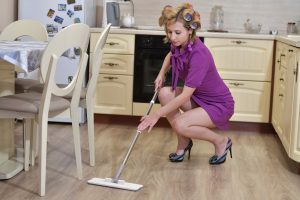Common Household Hot Spots That Need Dusting

Dusting is a simple yet crucial weekly task for maintaining a clean and healthy home. Dirt accumulates quickly in frequently used areas, making regular dusting essential. Follow along as I unveil the five most common areas that require a weekly dusting routine, each with their own specific cleaning approach.
Top Five Common Areas That Need Dusting:
#1
TV screens/electronics – First, power down and unplug your device. Now, find and use a microfiber cloth to gently wipe down the screen of any dust. You will then have to lightly dampen the cloth with distilled water to clean off any marks and fingerprints from the screen. Be sure to clean the frame of the device with a cloth that is dry, and you may need to use an air duster to spray into really dirty ports if your cloth does not work. Let everything try out before you look it over and plug it back in again.

#2
Baseboards – Dusting baseboards can be boring, but they need to be done! Get that microfiber cloth ready with a bucket of warm water and dish soap. Dampen your cloth, wring it out, and use it to gently wipe down your baseboards. Get everywhere you can, even the corners. Once the cloth gets dirty, wring it out in the bucket of warm water. Add in more water and dish soap if desired. Continue doing this until you have cleaned all your baseboards. Once you are through, be sure to dry all your baseboards with a new dry microfiber cloth to prevent water spots.
#3
Lampshades – Dusting lampshades depends on the type you have. There’s fabric, glass, wicker, and rattan lampshades. Let’s go over glass lampshades for now, and please ask me about others later. First, turn off and unplug your lamp. Then, find and use a feather duster to remove any loose dust that is on your glass lampshade. Now, dampen a microfiber cloth with water and wring out the excess water. Thoroughly wipe down your glass lampshade getting rid of any fingerprints and smudges that may be on it. If it is really dirty, you may have to add dish soap to your dampened microfiber cloth. Now wipe down the lampshade with a dry clean cloth, and let the lampshade sit to air out.
#4
Window blinds – There are multiple window blinds. Dusting window blinds depends on the type you have. We will discuss how to dust cellular blinds/shades. Lower your blinds completely. This allows you to completely clean each cell of it. Use a microfiber cloth to wipe down each cell of the blind. Start from the top and work your way down. Be careful when doing this as it is easy to poke through these blinds and damage them. If there is mold or a stubborn stain of some kind, you will have to use a soapy solution to clean it. Once the shade is clean, wipe it down with a dry cloth completely. Let it air dry completely.
#5
Ceiling fans – First, you need to prepare for this dusting and cleaning. You will need a soft microfiber cloth with an optional hook piece or extension, a stepladder, and a bucket of warm water. Turn off and unplug the fan, and you will have to secure the fan blades using a fan blade stabilizer or similar tool to prevent the blades from spinning while you’re cleaning for your safety. Use your microfiber cloth to gently wipe down the top surface of each blade completely. Then, completely dust the bottom of each blade. Finally, wipe down the sides of each blade while being careful not to bend or damage any of the blades.
Extra Fan Fact:
Ceiling fans are always cleaned by professional cleaning services on a regular basis because of how dirty they can get. All that dust and dirt that builds up when they are not in use is a storm waiting to happen. A flip of the switch starts to swirl all that build up and dusting will have to be done on everything. A layer of dust throughout the living room or bedroom is not a nice touch for yourself, your guests, nor your pets.
Ceiling fans usually have something that is found in the middle of them called the motor housing. You will need your trusty microfiber cloth again to wipe down and remove any loose dust or debris from the motor housing. Optionally, you can then use compressed air to gently remove even more dust, but do not spray the air directly inside the housing. Give some time for the motor housing to air out before reattaching it. Once you have reattached your motor housing, you can then reattach your fan blades, or alternatively, turn on your fan. Not all ceiling fans are made alike.
